Discover 50 hidden attractions, cool sights, and unusual things to do in Spain. Don't miss out on these must-see attractions: Sagrada Família (Barcelona), Palacio Real (Madrid) or Park Güell (Barcelona).
Below, you can find the list of the most amazing places you should visit in Spain.
Table of Contents
Sagrada Família, Barcelona
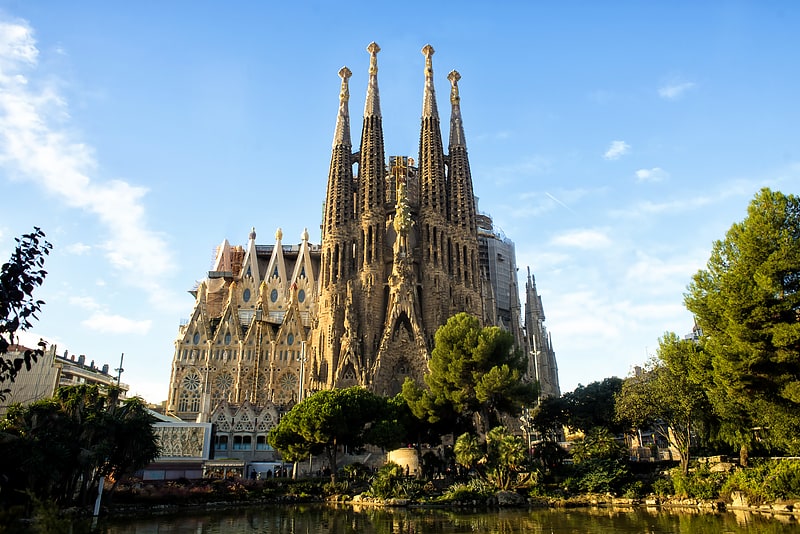
Also known as: Templo Expiatorio de la Sagrada Familia
Gaudí-designed landmark church. The Basílica i Temple Expiatori de la Sagrada Família, also known as the Sagrada Família, is a large unfinished minor basilica in the Eixample district of Barcelona, Catalonia, Spain. Designed by the Catalan architect Antoni Gaudí, his work on the building is part of a UNESCO World Heritage Site. On 7 November 2010, Pope Benedict XVI consecrated the church and proclaimed it a minor basilica.
On 19 March 1882, construction of the Sagrada Família began under architect Francisco de Paula del Villar. In 1883, when Villar resigned, Gaudí took over as chief architect, transforming the project with his architectural and engineering style, combining Gothic and curvilinear Art Nouveau forms. Gaudí devoted the remainder of his life to the project, and he is buried in the crypt. At the time of his death in 1926, less than a quarter of the project was complete.
Relying solely on private donations, the Sagrada Família's construction progressed slowly and was interrupted by the Spanish Civil War. In July 1936, revolutionaries set fire to the crypt and broke their way into the workshop, partially destroying Gaudí's original plans, drawings and plaster models, which led to 16 years of work to piece together the fragments of the master model. Construction resumed to intermittent progress in the 1950s. Advancements in technologies such as computer aided design and computerised numerical control (CNC) have since enabled faster progress and construction passed the midpoint in 2010. However, some of the project's greatest challenges remain, including the construction of ten more spires, each symbolising an important Biblical figure in the New Testament. It was anticipated that the building would be completed by 2026, the centenary of Gaudí's death, but this has now been delayed due to the COVID-19 pandemic.
The basilica has a long history of splitting opinion among the residents of Barcelona: over the initial possibility it might compete with Barcelona's cathedral, over Gaudí's design itself, over the possibility that work after Gaudí's death disregarded his design, and the 2007 proposal to build a tunnel nearby as part of Spain's high-speed rail link to France, possibly disturbing its stability. Describing the Sagrada Família, art critic Rainer Zerbst said "it is probably impossible to find a church building anything like it in the entire history of art", and Paul Goldberger describes it as "the most extraordinary personal interpretation of Gothic architecture since the Middle Ages". The basilica is not the cathedral church of the Archdiocese of Barcelona, as that title belongs to the Cathedral of the Holy Cross and Saint Eulalia.[1]
Address: Carrer de Mallorca, 401, 08013 Barcelona (Eixample)
Palacio Real, Madrid

Official residence in Madrid, Spain. The Royal Palace of Madrid is the official residence of the Spanish royal family at the city of Madrid, although now used only for state ceremonies. The palace has 135,000 m2 of floor space and contains 3,418 rooms. It is the largest functioning royal palace and the largest by floor area in Europe.
The palace is now open to the public, except during state functions, although it is so large that only a selection of rooms are on the visitor route at any one time, the route being changed every few months. An admission fee of €13 is charged; however, at some times it is free. The palace is owned by the Spanish state and administered by the Patrimonio Nacional, a public agency of the Ministry of the Presidency. The palace is on Calle de Bailén ("Bailén Street") in the western part of downtown Madrid, east of the Manzanares River, and is accessible from the Ópera metro station. Felipe VI and the royal family do not reside in the palace, choosing instead the Palace of Zarzuela in El Pardo.
The palace is on the site of a bygone Muslim-era fortress constructed by Emir Muhammad I of Córdoba in the 9th century. The imposing Alcázar of Madrid provided both a safe for the royal treasure and a habitual residence to the Trastámara monarchs in the late middle ages. Having endured substantial expansion works during the 16th century, the royal alcázar remained on the site until it burned down on 24 December 1734. A new palace was thereafter built from scratch on the same site on behalf of the Bourbon dynasty. Construction spanned the years 1738 to 1755 and followed a Berniniesque design by Filippo Juvarra and Giovanni Battista Sacchetti in cooperation with Ventura Rodríguez, Francesco Sabatini, and Martín Sarmiento. During the Second Spanish Republic the building was known as "Palacio Nacional".
The interior of the palace is notable for its wealth of art and the use of many types of fine materials in the construction and the decoration of its rooms. It includes paintings by artists such as Caravaggio, Juan de Flandes, Francisco de Goya, and Velázquez, and frescoes by Giovanni Battista Tiepolo, Corrado Giaquinto, and Anton Raphael Mengs. Other collections of great historical and artistic importance preserved in the building include the Royal Armoury of Madrid, porcelain, watches, furniture, silverware, and the world's only complete Stradivarius string quintet.[2]
Address: Plaza de la Armería, 1, 28013 Madrid (Centro Madrid)
Park Güell, Barcelona
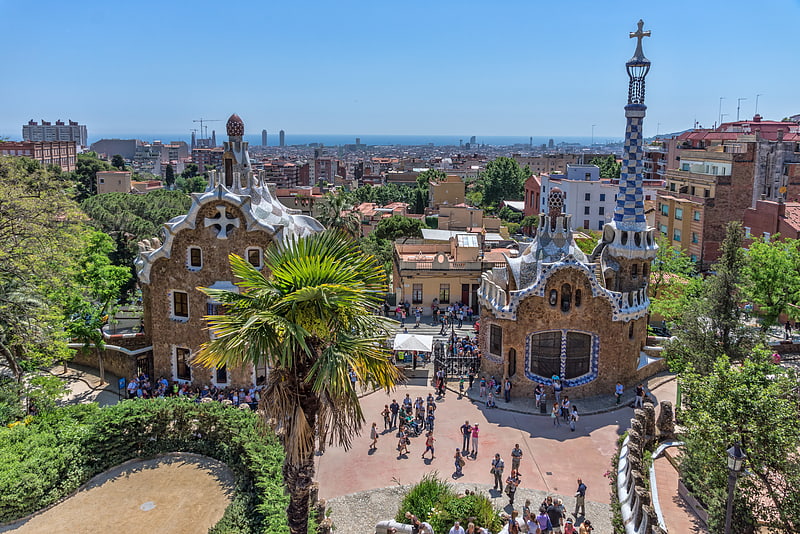
Also known as: Parque Güell
Park with Gaudi's sculptural buildings. Parc Güell is a privatized park system composed of gardens and architectural elements located on Carmel Hill, in Barcelona, Catalonia, Spain. Carmel Hill belongs to the mountain range of Collserola – the Parc del Carmel is located on the northern face. Park Güell is located in La Salut, a neighborhood in the Gràcia district of Barcelona. With urbanization in mind, Eusebi Güell assigned the design of the park to Antoni Gaudí, a renowned architect and the face of Catalan modernism.
The park was built from 1900 to 1914 and was officially opened as a public park in 1926. In 1984, UNESCO declared the park a World Heritage Site under "Works of Antoni Gaudí".[3]
Address: Carrer d'Olot, 5, 08024 Barcelona (Gràcia)
Casa Milà, Barcelona
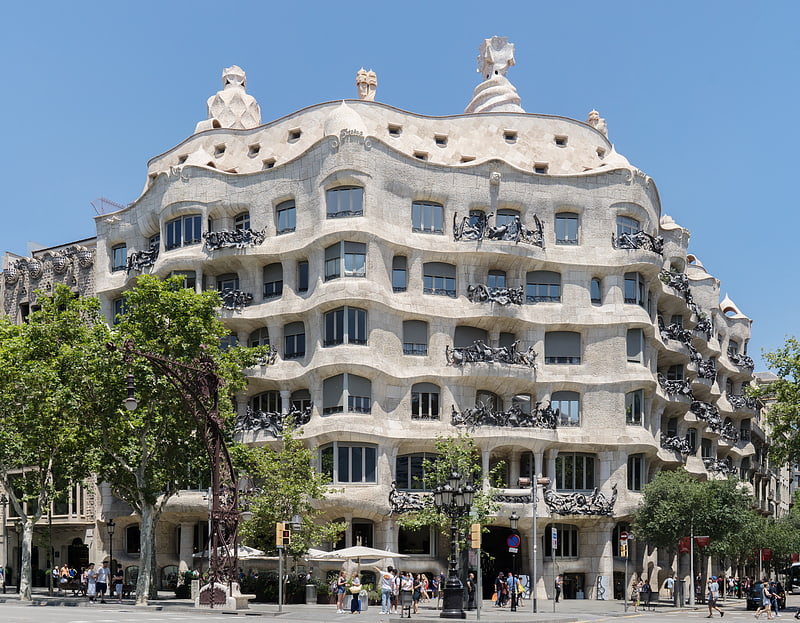
Gaudi masterpiece housing arts venue. Casa Milà, popularly known as La Pedrera or "The stone quarry", a reference to its unconventional rough-hewn appearance, is a Modernista building in Barcelona, Catalonia, Spain. It was the last private residence designed by architect Antoni Gaudí and was built between 1906 and 1912.
The building was commissioned in 1906 by Pere Milà and his wife Roser Segimon. At the time, it was controversial because of its undulating stone facade, twisting wrought iron balconies and designed by Josep Maria Jujol. Several structural innovations include a self-supporting stone façade, and a free-plan floor, underground garage and the spectacular terrace on the roof.
In 1984, it was declared a World Heritage Site by UNESCO. Since 2013 it has been the headquarters of the Fundació Catalunya La Pedrera which manages the visit to the building, exhibitions and other cultural and educative activities at Casa Milà.[4]
Address: Barcelona, 92, Passeig de Gràcia
Museo del Prado, Madrid

World-class European art collection. The Prado Museum, officially known as Museo Nacional del Prado, is the main Spanish national art museum, located in central Madrid. It is widely considered to house one of the world's finest collections of European art, dating from the 12th century to the early 20th century, based on the former Spanish Royal Collection, and the single best collection of Spanish art. Founded as a museum of paintings and sculpture in 1819, it also contains important collections of other types of works. The Prado Museum is one of the most visited sites in the world, and is considered one of the greatest art museums in the world. The numerous works by Francisco Goya, the single most extensively represented artist, as well as by Hieronymus Bosch, El Greco, Peter Paul Rubens, Titian, and Diego Velázquez, are some of the highlights of the collection. Velázquez and his keen eye and sensibility were also responsible for bringing much of the museum's fine collection of Italian masters to Spain, now the largest outside Italy.
The collection currently comprises around 8,200 drawings, 7,600 paintings, 4,800 prints, and 1,000 sculptures, in addition to many other works of art and historic documents. As of 2012, the museum displayed about 1,300 works in the main buildings, while around 3,100 works were on temporary loan to various museums and official institutions. The remainder were in storage.
Due to the COVID-19 pandemic, in 2020 attendance plunged by 76 percent to 852,161. Nonetheless, the Prado was ranked as the 16th most-visited museum in the list of most-visited art museums in the world in 2020. It is one of the largest museums in Spain.
The Prado, with the nearby Thyssen-Bornemisza Museum and the Museo Reina Sofía, forms Madrid's Golden Triangle of Art, which was included in the UNESCO World Heritage list in 2021.[5]
Address: Paseo del Prado, s/n, 28014 Madrid (Retiro)
Museo Thyssen-Bornemisza, Madrid
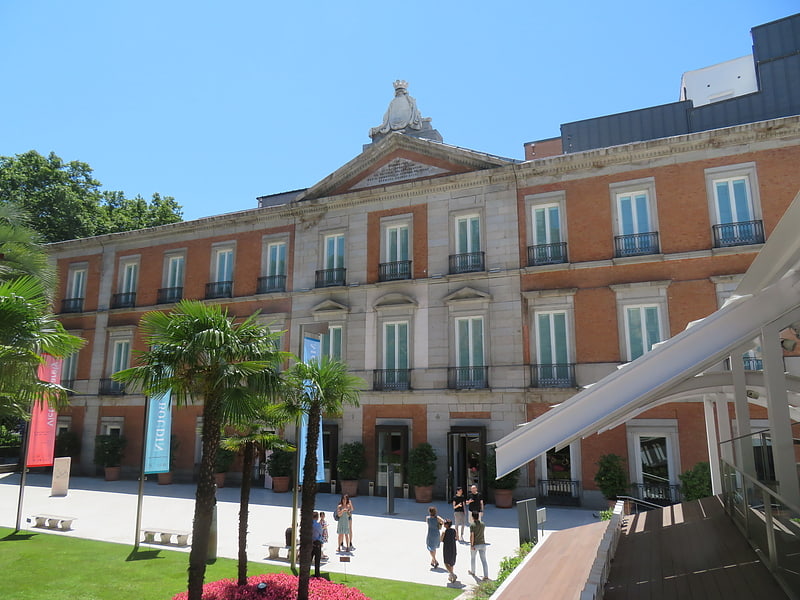
European art from 13th to 20th centuries. The Thyssen-Bornemisza National Museum, or simply the Thyssen, is an art museum in Madrid, Spain, located near the Prado Museum on one of the city's main boulevards. It is known as part of the "Golden Triangle of Art", which also includes the Prado and the Reina Sofia national galleries. The Thyssen-Bornemisza fills the historical gaps in its counterparts' collections: in the Prado's case this includes Italian primitives and works from the English, Dutch and German schools, while in the case of the Reina Sofia it concerns Impressionists, Expressionists, and European and American paintings from the 20th century.
With over 1,600 paintings, it was once the second largest private collection in the world after the British Royal Collection. A competition was held to house the core of the collection in 1987–88 after Baron Thyssen, having unsuccessfully sought permission to enlarge his Museum in Lugano (Villa Favorita), searched for a better-suited location elsewhere in Europe.[6]
Address: Paseo del Prado, 8, 28014 Madrid (Centro Madrid)
Generalife, Granada
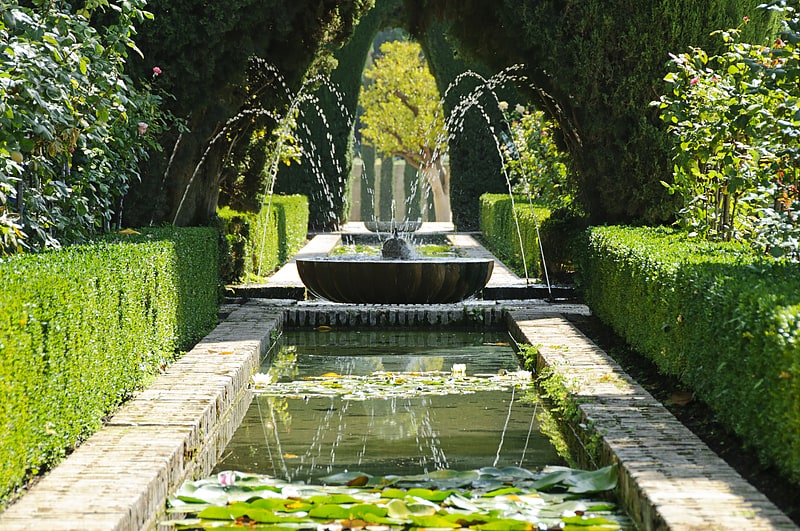
Palace in Granada, Spain. The Generalife was a summer palace and country estate of the Nasrid rulers of the Emirate of Granada in Al-Andalus. It is located directly east of and uphill from the Alhambra palace complex in Granada, Spain.[7]
Mosque–Cathedral of Córdoba, Córdoba
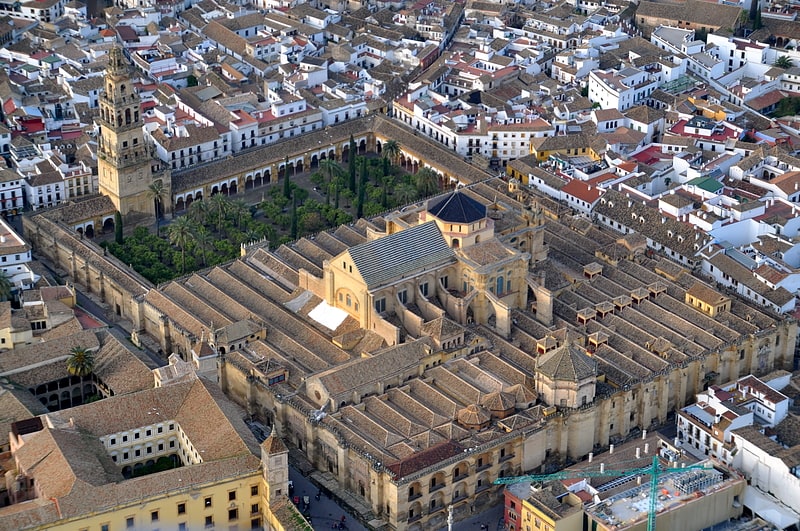
Also known as: Mezquita-catedral de Córdoba
Iconic Moorish architecture . The Mosque–Cathedral of Córdoba, officially known by its ecclesiastical name, the Cathedral of Our Lady of the Assumption, is the cathedral of the Roman Catholic Diocese of Córdoba dedicated to the Assumption of Mary and located in the Spanish region of Andalusia. Due to its status as a former Islamic mosque, it is also known as the Mezquita and as the Great Mosque of Córdoba.
According to traditional accounts a Visigothic church, the Catholic Christian Basilica of Saint Vincent of Saragossa, originally stood on the site of the current Mosque-Cathedral, although the historicity of this narrative has been questioned by scholars. The Great Mosque was constructed on the orders of Abd ar-Rahman I in 785 CE, when Córdoba was the capital of the Muslim-controlled region of Al-Andalus. It was expanded multiple times afterwards under Abd ar-Rahman's successors up to the late 10th century. Among the most notable additions, Abd ar-Rahman III added a minaret (finished in 958) and his son Al-Hakam II added a richly-decorated new mihrab and maqsura section (finished in 971). The mosque was converted to a cathedral in 1236 when Córdoba was captured by the Christian forces of Castile during the Reconquista. The structure itself underwent only minor modifications until a major building project in the 16th century inserted a new Renaissance cathedral nave and transept into the center of the building. The former minaret, which had been converted to a bell tower, was also significantly remodelled around this time. Starting in the 19th century, modern restorations have in turn led to the recovery and study of some of the building's Islamic-era elements. Today, the building continues to serve as the city's cathedral and Mass is celebrated therein daily.
The mosque structure is regarded as an important monument in the history of Islamic architecture and is considered by many scholars to have been highly influential on the subsequent "Moorish" architecture of the western Mediterranean regions of the Muslim world. It is also one of Spain's major historic monuments and tourist attractions, as well as a UNESCO World Heritage Site since 1984.[8]
Address: Calle del Cardenal Herrero, 1, 14003 Cordoba (Centro de Córdoba)
Alhambra, Granada

Fortified hilltop Moorish complex. The Alhambra is a palace and fortress complex located in Granada, Andalusia, Spain. It is one of the most famous monuments of Islamic architecture and one of the best-preserved palaces of the historic Islamic world, in addition to containing notable examples of Spanish Renaissance architecture.
The complex was begun in 1238 by Muhammad I Ibn al-Ahmar, the first Nasrid emir and founder of the Emirate of Granada, the last Muslim state of Al-Andalus. It was built on the Sabika hill, an outcrop of the Sierra Nevada which had been the site of earlier fortresses and of the 11th-century palace of Samuel ibn Naghrillah. Later Nasrid rulers continuously modified the site. The most significant construction campaigns, which gave the royal palaces much of their definitive character, took place in the 14th century during the reigns of Yusuf I and Muhammad V. After the conclusion of the Christian Reconquista in 1492, the site became the Royal Court of Ferdinand and Isabella (where Christopher Columbus received royal endorsement for his expedition), and the palaces were partially altered. In 1526, Charles V of Spain commissioned a new Renaissance-style palace in direct juxtaposition with the Nasrid palaces, but it was left uncompleted in the early 17th century. After being allowed to fall into disrepair for centuries, with its buildings occupied by squatters, the Alhambra was rediscovered following the defeat of Napoleon I, whose troops destroyed parts of the site. The rediscoverers were first British intellectuals and then other American and northern European Romantic travelers. The most influential of them was Washington Irving, whose Tales of the Alhambra (1832) brought international attention to the site. The Alhambra was one of the first Islamic monuments to become the object of modern scientific study and has been the subject of numerous restorations since the 19th century. It is now one of Spain's major tourist attractions and a UNESCO World Heritage Site.
During the Nasrid era, the Alhambra was a self-contained city separate from the rest of Granada below. It contained most of the amenities of a Muslim city such as a Friday mosque, hammams (public baths), roads, houses, artisan workshops, a tannery, and a sophisticated water supply system. As a royal city and citadel, it contained at least six major palaces, most of them located along the northern edge where they commanded views over the Albaicín quarter. The most famous and best-preserved are the Mexuar, the Comares Palace, the Palace of the Lions, and the Partal Palace, which form the main attraction to visitors today. The other palaces are known from historical sources and from modern excavations. At the Alhambra's western tip is the Alcazaba fortress. Multiple smaller towers and fortified gates are also located along the Alhambra's walls. Outside the Alhambra walls and located nearby to the east is the Generalife, a former Nasrid country estate and summer palace accompanied by historic orchards and modern landscaped gardens.
The architecture of the Nasrid palaces reflects the tradition of Moorish architecture developed over previous centuries. It is characterized by the use of the courtyard as a central space and basic unit around which other halls and rooms were organized. Courtyards typically had water features at their center, such as a reflective pool or a fountain. Decoration was focused on the inside of the building and was executed primarily with tile mosaics on lower walls and carved stucco on the upper walls. Geometric patterns, vegetal motifs, and Arabic inscriptions were the main types of decorative motifs. Additionally, "stalactite"-like sculpting, known as muqarnas, was used for three-dimensional features like vaulted ceilings.[9]
Address: Calle Real de la Alhambra, s/n, 18009 Granada (Centro de Granada)
Seville Cathedral, Seville
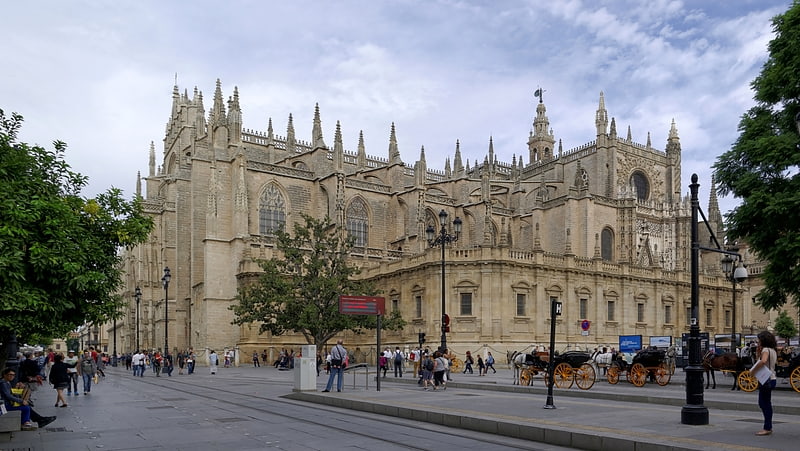
Also known as: Catedral de Sevilla
Gothic structure with iconic bell tower. The Cathedral of Saint Mary of the See, better known as Seville Cathedral, is a Roman Catholic cathedral in Seville, Andalusia, Spain. It was registered in 1987 by UNESCO as a World Heritage Site, along with the adjoining Alcázar palace complex and the General Archive of the Indies. It is the fourth-largest church in the world as well as the largest Gothic church.
After its completion in the early 16th century, Seville Cathedral supplanted Hagia Sophia as the largest cathedral in the world, a title the Byzantine church had held for a thousand years. The Gothic section alone has a length of 126 m (413 ft), a width of 76 m (249 ft), and its maximum height in the center of the transept is 42 m (138 ft). The total height of the Giralda tower from the ground to the weather vane is 104.5 m (342 ft 10 in).
Seville Cathedral was the site of the baptism of Infante Juan of Aragon in 1478, only son of the Catholic Monarchs Ferdinand II of Aragon and Isabella I of Castile. Its royal chapel holds the remains of the city's conqueror Ferdinand III of Castile, his son and heir Alfonso the Wise and their descendant king Peter the Just. The funerary monuments for cardinals Juan de Cervantes and Pedro González de Mendoza are located among its chapels. Christopher Columbus and his son Diego are also buried in the cathedral.
The Archbishop's Palace is located on the northeastern side of the cathedral.[10]
Address: Av. de la Constitución, s/n, 41004 Sevilla (Casco Antiguo)
Alcázar of Seville, Seville
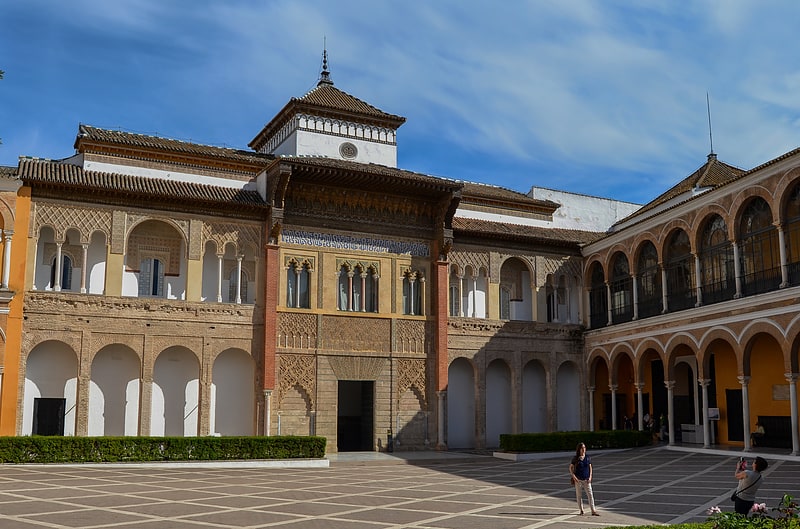
Also known as: Real Alcázar de Sevilla
Iconic Moorish-Renaissance royal palace. The Royal Alcázars of Seville, historically known as al-Qasr al-Muriq and commonly known as the Alcázar of Seville, is a royal palace in Seville, Spain, built for the Christian king Peter of Castile. It was built by Castilian Christians on the site of an Abbadid Muslim alcazar, or residential fortress. The fortress was destroyed after the Christian conquest of Seville in 1248.
The palace is a preeminent example of Mudéjar style in the Iberian Peninsula, combining Romanesque, Gothic, and Renaissance structural elements. The upper stories of the Alcázar are still occupied by the royal family when they visit Seville and are administered by the Patrimonio Nacional. It was registered in 1987 by UNESCO as a World Heritage Site, along with the adjoining Seville Cathedral and the General Archive of the Indies.[11]
Address: Patio de Banderas, s/n, 41004 Sevilla (Casco Antiguo)
Giralda, Seville
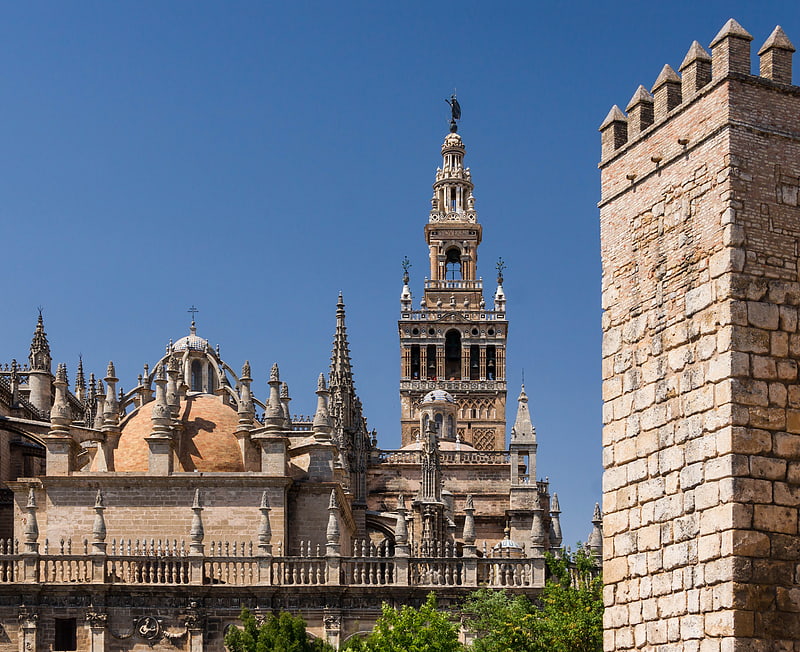
Bell tower atop a former minaret. The Giralda is the bell tower of Seville Cathedral in Seville, Spain. It was built as the minaret for the Great Mosque of Seville in al-Andalus, Moorish Spain, during the reign of the Almohad dynasty, with a Renaissance-style belfry added by the Catholics after the expulsion of the Muslims from the area. The Giralda was registered in 1987 as a World Heritage Site by UNESCO, along with the Alcázar and the General Archive of the Indies. The tower is 104.1 m in height and remains one of the most important symbols of the city, as it has been since the Middle Ages.[12]
Address: Av. de la Constitución, s/n, 41004 Sevilla (Casco Antiguo)
Madinat al-Zahra, Córdoba
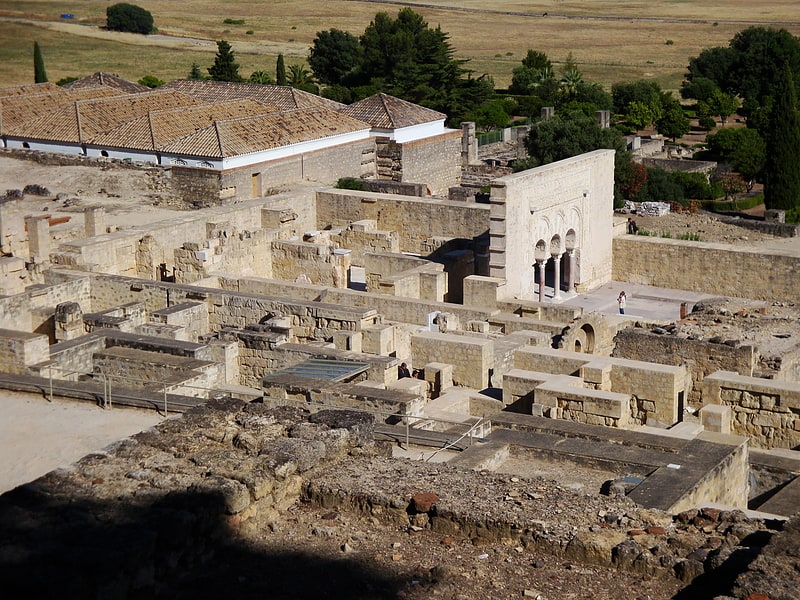
Also known as: Medina Azahara
Ruins of 10th-century palace buildings. Madinat al-Zahra or Medina Azahara was a fortified palace-city on the western outskirts of Córdoba in present-day Spain. Its remains are a major archaeological site today. The city was built in the 10th century by Abd-ar-Rahman III, a member of the Umayyad dynasty and the first caliph of Al-Andalus. It served as the capital of the Caliphate of Córdoba and its center of government.
The main reason for its construction was politico-ideological: Abd ar-Rahman III had declared himself "caliph" in 929 and the dignity of this new title required the establishment of a new city, a symbol of his power, imitating other eastern Caliphates. It sought to demonstrate his superiority over his great rivals, the Fatimid Caliphs of Ifriqiya in North Africa and the Abbasid Caliphs in Baghdad. The city was built near Córdoba, the existing capital of al-Andalus under Umayyad rule. Construction began in 936–940 and continued in multiple phases throughout his reign and the reign of his son son, Al-Hakam II (r. 961–976). The new city included ceremonial reception halls, a congregational mosque, administrative and government offices, aristocratic residences, gardens, a mint, workshops, barracks, service quarters, and baths. Water was supplied through aqueducts. After al-Hakam II's death, however, the city ceased to act as the center of government under the rule of Ibn Abi Amir al-Mansur (Almanzor). Between 1010 and 1013 it was sacked during a civil war and thereafter abandoned, with many of its materials re-used elsewhere.
The ruins of the city were excavated starting in 1911. Only about 10 hectares of the 112 hectares (0.43 sq mi) of the city have been excavated and partially restored, but this area includes the main palaces. A dedicated archeological museum, located on the edge of the site, was opened in 2009. On July 1, 2018, the site was listed as a UNESCO World Heritage Site with the inscription name "Caliphate City of Medina Azahara".[13]
Address: Ctra. Palma del Río, km 5.5, 14005 Córdoba
Camino de Santiago, Santiago de Compostela

Route. The Camino de Santiago, known in English as the Way of St James, is a network of pilgrims' ways or pilgrimages leading to the shrine of the apostle Saint James the Great in the cathedral of Santiago de Compostela in Galicia in northwestern Spain, where tradition holds that the remains of the apostle are buried.
As Pope Benedict XVI said, "It is a way sown with so many demonstrations of fervour, repentance, hospitality, art and culture which speak to us eloquently of the spiritual roots of the Old Continent." Many follow its routes as a form of spiritual path or retreat for their spiritual growth. It is also popular with hiking and cycling enthusiasts and organized tour groups.
Created and established after the discovery of the relics of James of Zebedee at the beginning of the 9th century, the Way of St James became a major pilgrimage route of medieval Christianity from the 10th century onwards. But it was only after the capture of Granada in 1492, under the reign of Ferdinand II of Aragon and Isabella I of Castile, that Pope Alexander VI officially declared the Camino de Santiago to be one of the "three great pilgrimages of Christendom", along with Jerusalem and Rome.
In 1987, the Camino de Santiago, which encompasses several routes in Spain, France and Portugal, was declared the first Cultural Route of the Council of Europe. Since 2013, the Camino de Santiago has attracted more than 200,000 pilgrims each year, with an annual growth rate of more than 10 percent. Pilgrims come mainly on foot and often from nearby cities, requiring several days of walking to reach Santiago. The French Way gathers two-thirds of the walkers, but other minor routes are experiencing a growth in popularity. The French Way and the routes in Spain were inscribed on the UNESCO World Heritage List, followed by the routes in France in 1998, because of their historical significance for Christianity as a major pilgrimage route and their testimony to the exchange of ideas and cultures across the routes.[14]
Aljafería, Zaragoza
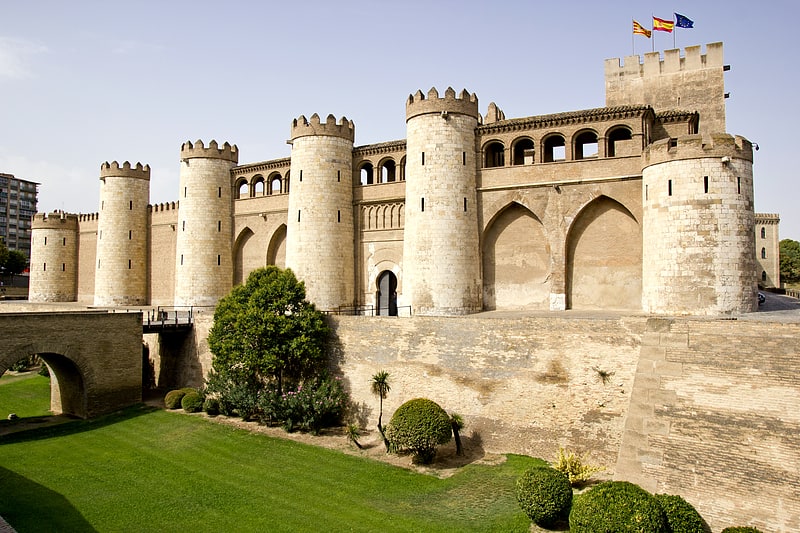
Medieval Islamic palace/Parliament seat. The Aljafería Palace is a fortified medieval palace built during the second half of the 11th century in the Taifa of Zaragoza in Al-Andalus, present day Zaragoza, Aragon, Spain. It was the residence of the Banu Hud dynasty during the era of Abu Jaffar Al-Muqtadir. The palace reflects the splendor attained by the Taifa of Zaragoza at its height. It currently houses the Cortes of the autonomous community of Aragon.
The structure is the only conserved large example of Spanish Islamic architecture from the era of the taifas (independent kingdoms). The Aljafería, along with the Mosque–Cathedral of Córdoba and the Alhambra, are the three best examples of Hispano-Muslim architecture and have special legal protection. In 2001, the original restored structures of the Aljafería were included in the Mudéjar Architecture of Aragon, a World Heritage Site.
The style of ornamentation of the Aljafería, such as the use of mixtilinear arches and springers, the extension of arabesques over a large area, and the schematisation and progressive abstraction of the yeserias of a vegetal nature, strongly influenced Almoravid and Almohad art in the Iberian Peninsula. The shift in decoration towards more geometric motifs is at the basis of Nasrid art.
After the reconquest of Zaragoza in 1118 by Alfonso I of Aragón, it became the residence of the Christian kings of the Kingdom of Aragón. It was used as a royal residence by Peter IV of Aragón (1319–1387) and, in 1492, it was converted into the palace of the Catholic Monarchs. In 1593 it underwent another restructuring that would turn it into a military fortress, first according to Renaissance designs (which today can be seen in its surroundings, moat, and gardens) and later for quartering military regiments. It underwent further restructuring and damage, especially with the Sieges of Zaragoza of the Peninsular War, until it was finally restored in the 20th century.
The palace was built outside Zaragoza's Roman walls, in the plain of the saría. With urban expansion over the centuries, it is now inside the city.[15]
Address: Calle de los Diputados, s/n, 50003 Zaragoza
Aqueduct of Segovia, Segovia

Also known as: Acueducto de Segovia
Towering Roman aqueduct with 167 arches. The Aqueduct of Segovia is a Roman aqueduct in Segovia, Spain. It is one of the best-preserved elevated Roman aqueducts and the foremost symbol of Segovia, as evidenced by its presence on the city's coat of arms.[16]
Address: Plaza del Azoguejo, 1, 40001 Segovia
Guggenheim Museum Bilbao, Bilbao
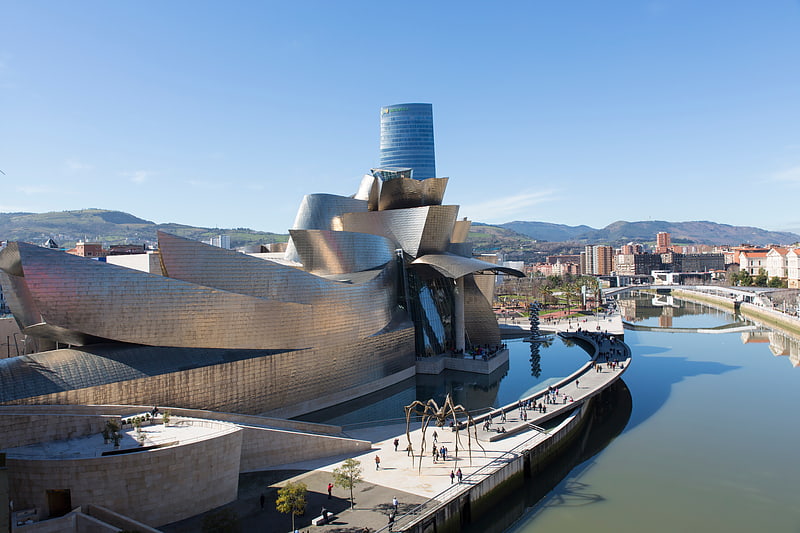
Also known as: Museo Guggenheim Bilbao
Frank Gehry-designed modern art museum. The Guggenheim Museum Bilbao is a museum of modern and contemporary art designed by Canadian-American architect Frank Gehry, and located in Bilbao, Basque Country, Spain. The museum was inaugurated on 18 October 1997 by King Juan Carlos I of Spain, with an exhibition of 250 contemporary works of art. Built alongside the Nervion River, which runs through the city of Bilbao to the Cantabrian Sea, it is one of several museums belonging to the Solomon R. Guggenheim Foundation and features permanent and visiting exhibits of works by Spanish and international artists. It is one of the largest museums in Spain. In 2020, the museum had 315,908 visitors, down 73 percent from 2019, due to the COVID-19 pandemic. It ranked 73rd on the list of most-visited art museums in 2020.
One of the most admired works of contemporary architecture, the building has been hailed as a "signal moment in the architectural culture", because it represents "one of those rare moments when critics, academics, and the general public were all completely united about something", according to architectural critic Paul Goldberger. The museum was the building most frequently named as one of the most important works completed since 1980 in the 2010 World Architecture Survey among architecture experts.[17]
Address: Abandoibarra Etorb., 2, 48009 Bilbo (Abando)
Partal Palace, Granada
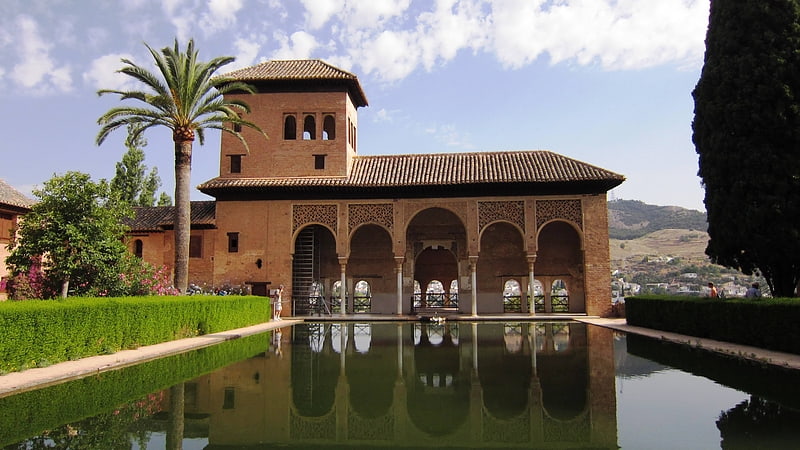
Partal Palace is a palatial structure inside the Alhambra fortress complex located in Granada, Spain. It was originally built in the early 14th century by the Nasrid ruler Muhammad III, making it the oldest surviving palatial structure in the Alhambra.[18]
Alcázar de Segovia, Segovia
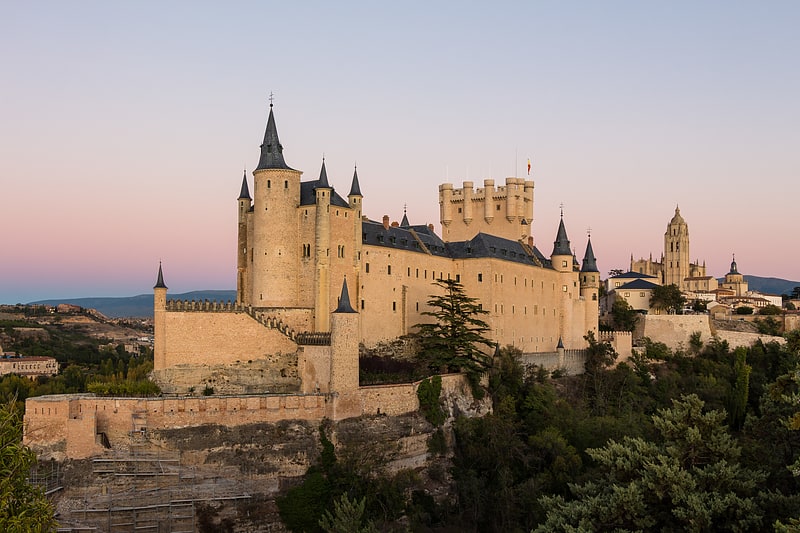
Restored 12th century castle. The Alcázar of Segovia is a medieval castle located in the city of Segovia, Castile and León, Spain. The fortress is a World Heritage Site by UNESCO. Rising out on a rocky crag above the confluence of two rivers near the Guadarrama mountains, it is one of the most distinctive castle-palaces in Spain by virtue of its shape – like the bow of a ship. The alcázar was originally built to serve as a fortress but has served as a royal palace, a state prison, a Royal Artillery College, and a military academy since then. It is currently used as a museum and a military archives building.[19]
Address: Plaza Reina Victoria Eugenia, s/n, 40003 Segovia
Santiago de Compostela Cathedral, Santiago de Compostela

Also known as: Catedral de Santiago de Compostela
Landmark 11th-century cathedral. The Santiago de Compostela Archcathedral Basilica is part of the Metropolitan Archdiocese of Santiago de Compostela and is an integral component of the Santiago de Compostela World Heritage Site in Galicia, Spain. The cathedral is the reputed burial place of Saint James the Great, one of the apostles of Jesus Christ. It is also among the remaining churches in the world built over the tomb of an apostle, the other ones being St Peter's Basilica in Vatican City, St Thomas Cathedral Basilica, Chennai in India and Basilica of St. John in Izmir, Turkey.
The archcathedral basilica has historically been a place of pilgrimage on the Way of St James since the Early Middle Ages and marks the traditional end of the pilgrimage route. The building is a Romanesque structure, with later Gothic and Baroque additions.[20]
Address: Praza do Obradoiro, s/n, 15704 Santiago de Compostela
Tower of Hercules, A Coruña
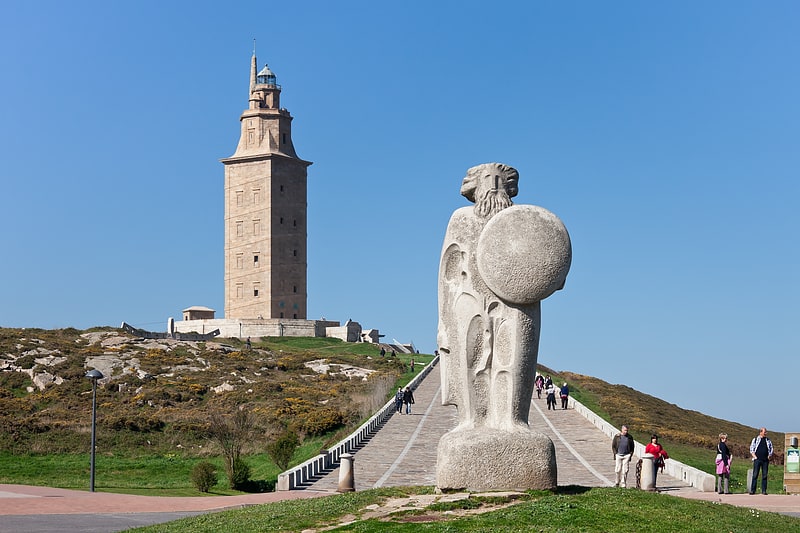
Also known as: Torre de Hércules
Oldest Roman lighthouse still in use. The Tower of Hercules is the oldest extant lighthouse known. It has an ancient Roman origin on a peninsula about 2.4 km from the centre of A Coruña, Galicia, in north-western Spain. Until the 20th century, it was known as the Farum Brigantium. The Latin word farum is derived from the Greek Φάρος, Pharos, for the Lighthouse of Alexandria. The structure stands 55 metres tall and overlooks the North Atlantic coast of Spain. It was built in the 1st century and competently renovated in 1791.
There is a sculpture garden featuring works by Pablo Serrano and Francisco Leiro. The Tower of Hercules is a National Monument of Spain, and has been a UNESCO World Heritage Site since 27 June 2009. It is the second-tallest lighthouse in Spain, after the Faro de Chipiona.[21]
Address: Av. Navarra, s/n, 15002 A Coruña
Alcázar de los Reyes Cristianos, Córdoba
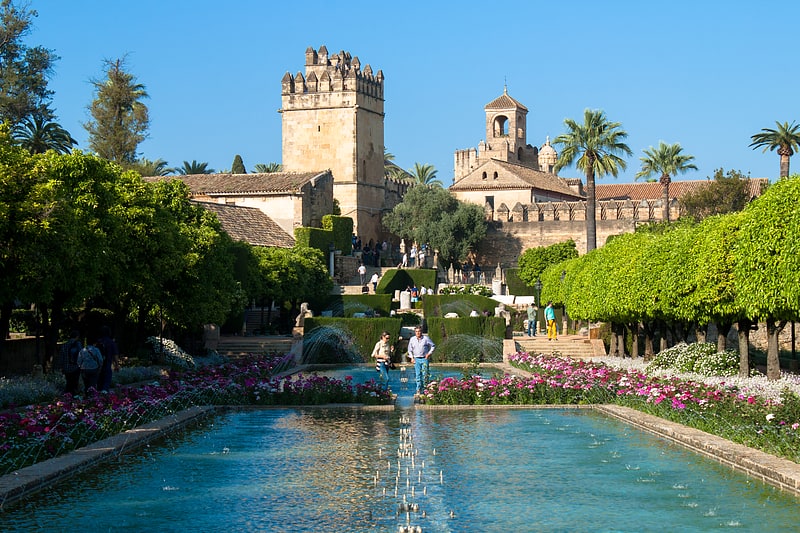
1328 Moorish palace with lush gardens. The Alcázar de los Reyes Cristianos, also known as the Alcázar of Córdoba, is a medieval alcázar located in the historic centre of Córdoba, next to the Guadalquivir River and near the Mosque-Cathedral. The fortress served as one of the primary residences of Isabella I of Castile and Ferdinand II of Aragon.
It is a building of military character whose construction was ordered by the King Alfonso XI of Castile in the year 1328, on previous constructions (the Islamic-era Umayyad Alcázar, also the previous residence of the Roman Governor and the Customs). The architectural ensemble has a sober character in its exterior and splendid in its interior, with the magnificent gardens and courtyards that maintain a Mudéjar inspiration.
The Alcázar has been declared a Cultural Interest Heritage since 1931. It forms part of the Historic Center of Córdoba that was declared a World Heritage Site by UNESCO in 1994.[22]
Address: Plaza Campo Santo de los Mártires, s/n, 14004 Córdoba (Centro de Córdoba)
Ciutat de les Arts i les Ciències, Valencia
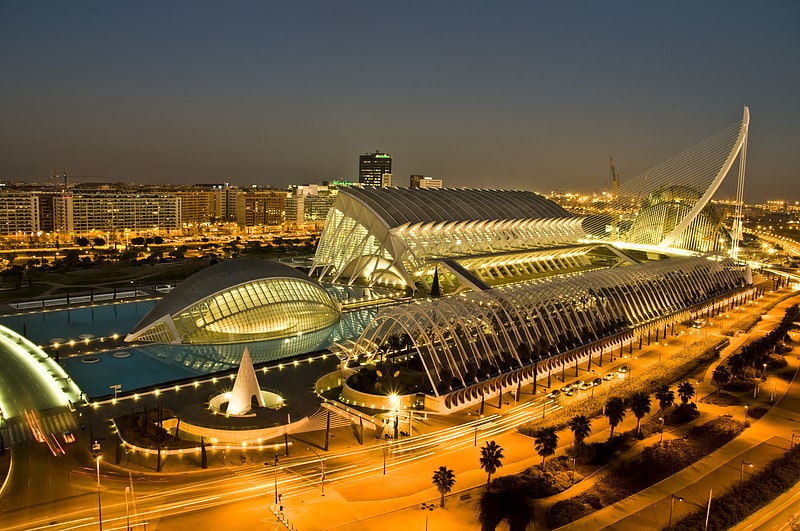
Also known as: Ciudad de las Artes y las Ciencias
State-of-the-art science and culture park. The City of Arts and Sciences is a cultural and architectural complex in the city of Valencia, Spain. It is the most important modern tourist destination in the city of Valencia and one of the 12 Treasures of Spain.
The City of Arts and Sciences is situated at the southeast end of the former riverbed of the river Turia, which was drained and rerouted after a catastrophic flood in 1957. The old riverbed was turned into a picturesque sunken park.
Designed by Santiago Calatrava and Félix Candela, the project began the first stages of construction in July 1996, and was inaugurated on 16 April 1998 with the opening of L'Hemisfèric. The last major component of the City of Arts and Sciences, Palau de les Arts Reina Sofía, was inaugurated on 9 October 2005, Valencian Community Day. The most recent building in the complex, L'Àgora, was opened in 2009.
Originally budgeted at €300 million in 1991 for three structures, it has expanded about three times the initial expected cost.[23]
Address: Av. del Professor López Piñero, 7, 46013 València (Cuatre Carreres)
Lonja de la Seda, Valencia
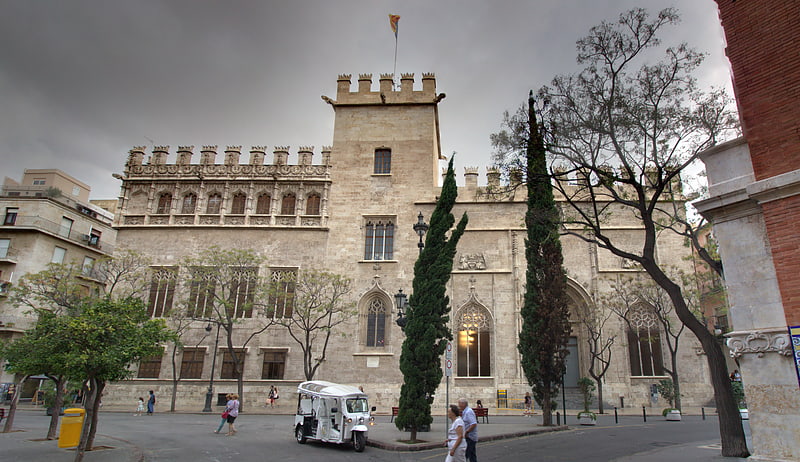
15th-century Gothic mercantile exchange. The Lonja de la Seda or Llotja de la Seda is a late Valencian Gothic-style civil building in Valencia, Spain. It is a principal tourist attraction in the city.[24]
Address: Plaza del Mercado, 46001 Valencia (Ciutat Vella)
Burgos Cathedral, Burgos

Also known as: Catedral de Burgos
13th-century Gothic place of worship. The Cathedral of Saint Mary of Burgos is a Catholic church dedicated to the Virgin Mary located in the historical center of the Spanish city of Burgos. Its official name is Santa Iglesia Catedral Basílica Metropolitana de Santa María de Burgos.
Its construction began in 1221, in the style of French Gothic architecture and is based on a Latin Cross. After a hiatus of almost 200 years, it went through major embellishments of great splendor in the 15th and 16th centuries: the spires of the main facade, the capilla del Condestable, 'Chapel of the Constable' and dome of the transept. These are elements of the flamboyant Gothic which gives the cathedral its unmistakable profile. The last works of importance (the Sacristy or the Chapel of Saint Thecla) were performed in the 18th century, during which the Gothic portals of the main facade were also modified. The style of the cathedral is the Gothic, although it has several decorative Renaissance and Baroque elements as well. The construction and renovations were made with limestone extracted from the quarries of the nearby town of Hontoria de la Cantera.
Many works of extraordinary artists are preserved in the cathedral, bearing testimony to the creative genius of architects and sculptors of the Colonia family (Juan, Simón and Francisco), the architect Juan de Vallejo, sculptors Gil de Siloé, Felipe Bigarny, Rodrigo de la Haya, Martín de la Haya, Juan de Ancheta and Juan Pascual de Mena, the sculptor and architect Diego de Siloé, the fencer Cristóbal de Andino, the glazier Arnao de Flandes and the painters Alonso de Sedano, Mateo Cerezo, Sebastiano del Piombo or Juan Ricci, among others.
The design of the main facade is related to the purest French Gothic style such as found in the contemporary great cathedrals of Paris and Reims, while the interior elevation refers to Bourges Cathedral. The facade consists of three stories topped by two lateral square bell towers. The spires, showing Germanic influence, were added in the 15th century by Juan de Colonia. The portals of Sarmental and la Coronería were constructed in 13th century Gothic style, while the portal de la Pellejería shows 16th century Plateresques-Renaissance influences.
The cathedral was declared a World Heritage Site by UNESCO on October 31, 1984. It is the only Spanish cathedral that has this distinction independently, without being joined to the historic center of a city (as in Salamanca, Santiago de Compostela, Ávila, Córdoba, Toledo, Alcalá de Henares or Cuenca) or in union with other buildings, as in Seville. It is similar in design to Brussels Cathedral.[25]
Address: Plaza Sta. María, 09003 Burgos
Santa María del Naranco, Oviedo
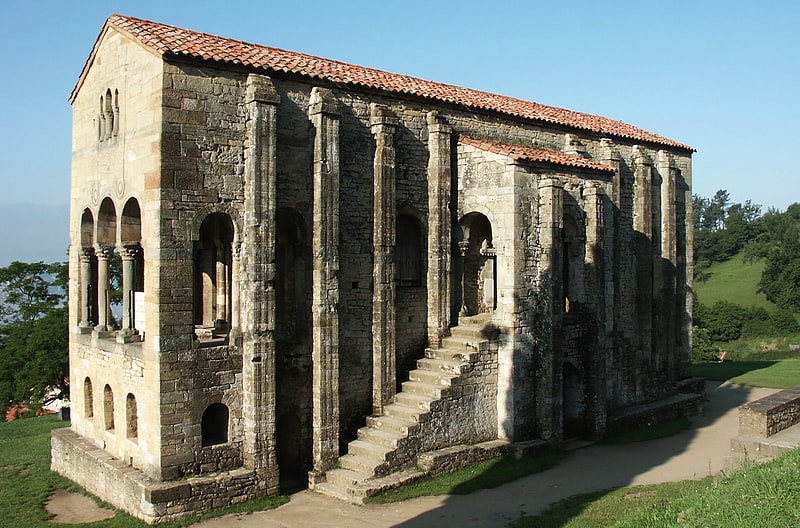
Preserved church from the 9th century. The church of St Mary at Mount Naranco is a pre-Romanesque Asturian building on the slope of Mount Naranco situated 3 kilometres from Oviedo, northern Spain. Ramiro I of Asturias ordered it to be built as a royal palace, part of a larger complex that also incorporated the nearby church of San Miguel de Lillo, 100 meters away. The palace was completed in 842 and had in part a religious function, being consecrated in 848. Its structural features, such as the barrel vault—with transverse ribs corresponding one-to-one with contraforts at the exterior, make it a clear precursor of the Romanesque construction. The exterior decorations, as well as the use of stilted arches mark the intended verticality of the composition.
It was declared a Monumento Nacional on 24 January 1885. Along with all other national monuments of Spain, it was classified as a Bien de Interés Cultural in June 1985. It was declared a World Heritage Site by UNESCO in December 1985.[26]
Address: Monte del Naranco, 33012 Oviedo
Queen Sofía Palace of the Arts, Valencia
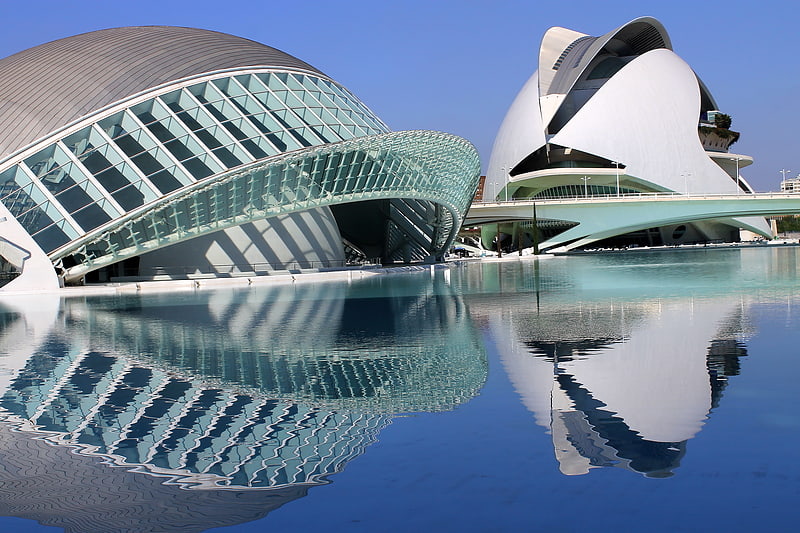
Also known as: Palacio de las Artes Reina Sofía
Contemporary venue for performing arts. Palau de les Arts Reina Sofía is an opera house, performing arts centre, and urban landmark designed by Santiago Calatrava to anchor the northwest end of the City of Arts and Sciences in Valencia, Spain. It opened on 8 October 2005; its first opera staging was of Beethoven's Fidelio on 25 October 2006. Tenor and conductor Plácido Domingo has maintained a special relationship with the Palau since its founding and has established a young singers training program there.[27]
Address: Av. del Professor López Piñero, 1, 46013 València (Cuatre Carreres)
Alcazaba, Málaga
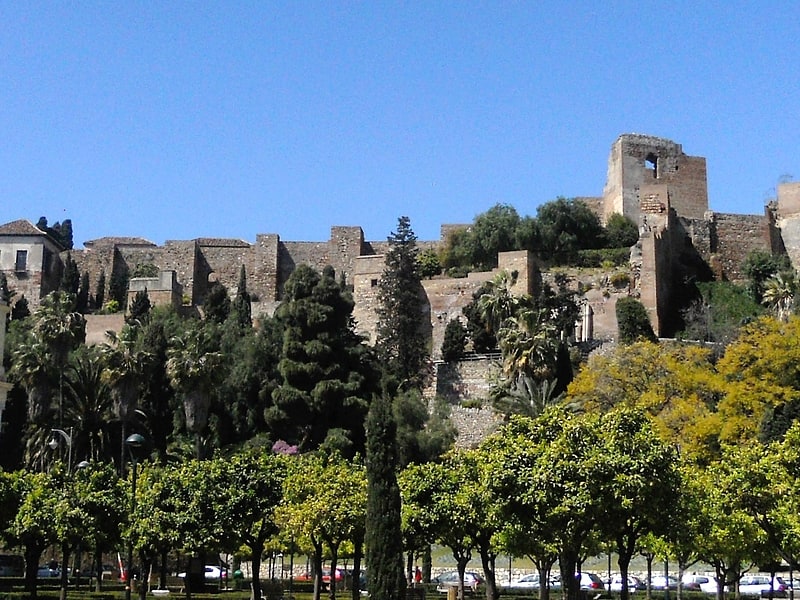
Medieval Moorish palace with sea views. The Alcazaba is a palatial fortification in Málaga, Spain. It was built by the Hammudid dynasty in the early 11th century.
It is the best-preserved alcazaba (from the Arabic al-qasbah, قصبة, meaning "citadel") in Spain. Adjacent to the entrance of the Alcazaba are remnants of a Roman theatre dating to the 1st century BC, which are undergoing restoration. Some of the Roman-era materials were reused in the Moorish construction of the Alcazaba. The Alcazaba was connected by a walled corridor to the higher Castle of Gibralfaro.
Ferdinand and Isabella captured Málaga from the Moors after the Siege of Málaga (1487), one of the longest sieges in the Reconquista, and raised their standard at the "Torre del Homenaje" in the inner citadel.
According to architect restorer, Leopoldo Torres Balbás, the Alcazaba of Málaga is the prototype of military architecture in the Taifa period, with its double walls and massive entry fortifications. Its only parallel is the castle of Krak des Chevaliers in Syria.[28]
Address: Calle Guillen Sotelo, 29016 Málaga (Málaga-Centro)
Bilbao Fine Arts Museum, Bilbao

Also known as: Museo de Bellas Artes de Bilbao
Medieval to modern art collection. The Bilbao Fine Arts Museum is an art museum located in the city of Bilbao, Spain. The building of the museum is located entirely inside the city's Doña Casilda Iturrizar park.
It is the second largest and most visited museum in the Basque Country, after the Bilbao Guggenheim Museum and one of the richest Spanish museums outside Madrid. It houses a valuable and quite comprehensive collection of Basque, Spanish and European art from the Middle Ages to contemporary, including paintings by old masters like El Greco, Cranach, Murillo, Goya, Van Dyck, Ruisdael and Bellotto, together with 19th century and modern: Sorolla, Mary Cassatt, Paul Gauguin, Henri Le Sidaner, James Ensor, Peter Blake, Francis Bacon and Richard Serra.[29]
Address: Museo Plaza, 2, 48009 Bilbo (Abando)
Bilbao Cathedral, Bilbao
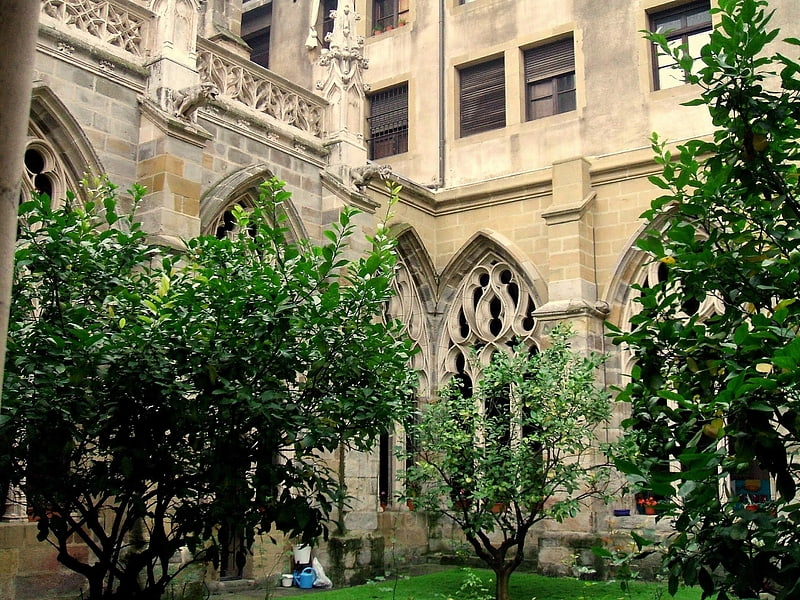
Also known as: Catedral de Santiago de Bilbao
Gothic-revival Catholic cathedral. Santiago Cathedral is a Roman Catholic church in the city of Bilbao. The temple was originally built during the 14th-15th centuries as Bilbao's main parish church, and was only declared cathedral in 1950 when the Roman Catholic Diocese of Bilbao was officially created. Its origins probably date to well before the foundation of the city in 1300, when Bilbao was little more than a small enclave of fishermen.
The temple is consecrated in honor of the apostle Saint James the Great (Santiago in Spanish), by virtue of being a point of transit for the pilgrims that followed the Northern branch of the Way of Saint James.
Architecturally, the present building is a mixture of styles: from the 15th century Gothic of the cloister and the main vault, where of special interest are the cloister and the beautiful portal that gives access Correo street (Puerta del Angel), to the ostentatious Gothic Revival façade and spire.
A curious custom is the addition of stone carvings of local merchants along the buttresses of the main vault.
It should not be confused with the Cathedral of Santiago de Compostela.
For various reasons, the San Mamés stadium, home of local football team Athletic Bilbao, was referred to as La Catedral several decades prior to the inauguration of Santiago Cathedral. A place of worship is depicted on the club's crest (as in the city coat of arms) but this is the nearby San Antón church and its bridge.[30]
Address: Plaza de Santiago, 1, 48005 Bilbo (Ibaiondo)
San Miguel de Lillo, Oviedo
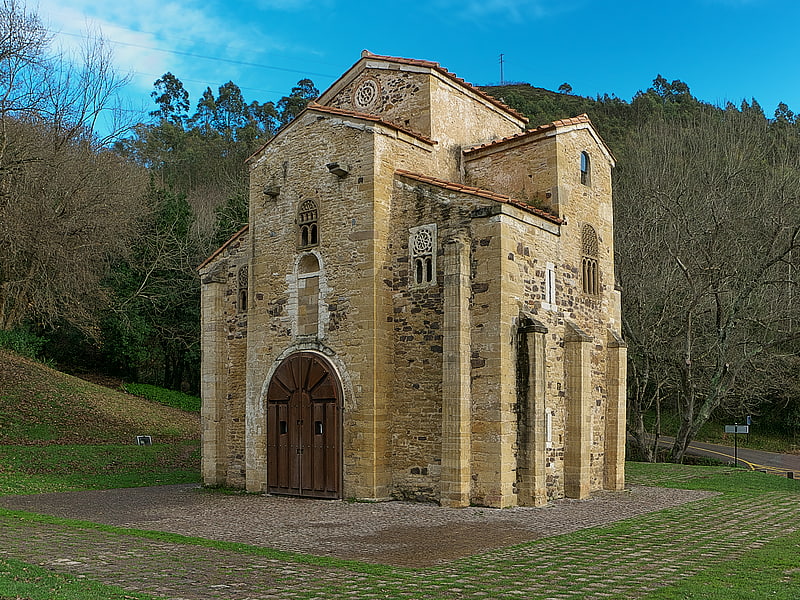
Small stone church from the 800s CE. St. Michael of Lillo is a Roman Catholic church built on the Naranco mount, near the Church of Santa María del Naranco in Asturias. It was completed in 842 and it was consecrated by Ramiro I of Asturias and his wife Paterna in the year 848. It was originally dedicated to St. Mary until this worship passed to the nearby palace in the 12th century, leaving this church dedicated to Saint Michael. It has been a UNESCO World Heritage Site since 1985.
It originally had a basilica ground plan, three aisles with a barrel vault, although part of the original structure has disappeared as the building collapsed during the 12th or 13th century. Nowadays, it conserves its western half from that period, together with several elements in the rest of the church such as the fantastic jambs in the vestibule or the extraordinary lattice on the window of the southern wall, sculpted from one single piece of stone.[31]
Address: Av. de los Monumentos, 33194 Oviedo
Bellver Castle, Palma de Mallorca
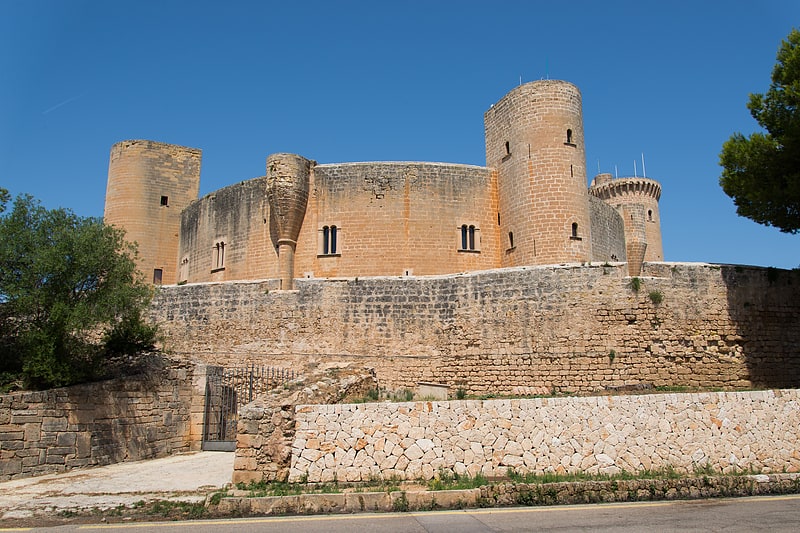
Also known as: Castillo de Bellver
Hilltop 1300s castle for panoramic views. Bellver Castle is a Gothic-style castle on a hill 3 km to the west of the center of Palma on the Island of Majorca, Balearic Islands, Spain. It was built in the 14th century for King James II of Majorca, and is one of the few circular castles in Europe. First serving as the residence of the Kings of Majorca, and afterward long used as a military prison throughout the 18th to mid-20th century, it is now under civilian control, being one of the main tourist attractions of the island, as well as the seat for the city's History Museum.[32]
Address: Carrer Camilo José Cela, s/n, 07014 Palma (Distrito Poniente)
Palma Cathedral, Palma de Mallorca

Also known as: Catedral de Santa María de Palma de Mallorca
Gothic place of worship on the seafront. The Cathedral of Santa Maria of Palma, more commonly referred to as La Seu, is a Gothic Roman Catholic cathedral located in Palma, Mallorca, Spain.[33]
Address: Plaça de la Seu, s/n, 07001 Palma (Distrito Centro)
New Cathedral of Salamanca, Salamanca
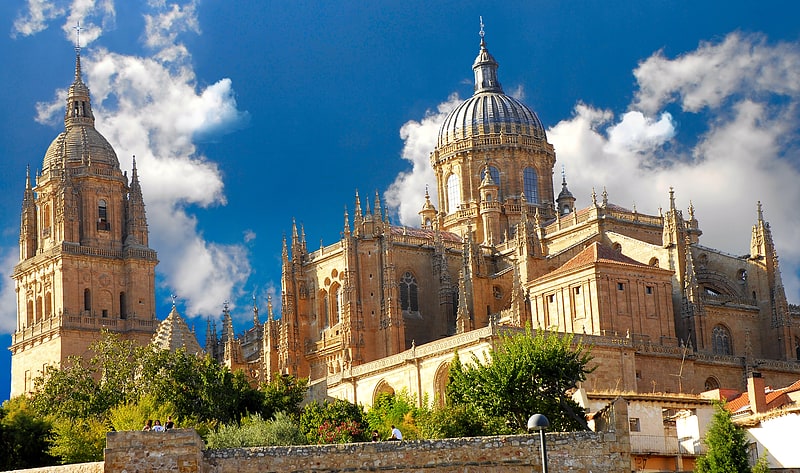
Also known as: Catedral Nueva de Salamanca
Ornate structure with unique carvings. The New Cathedral is, together with the Old Cathedral, one of the two cathedrals of Salamanca, Spain. It was constructed between the 16th and 18th centuries in two styles: late Gothic and Baroque. Building began in 1513 and the cathedral was consecrated in 1733. It was commissioned by Ferdinand V of Castile of Spain. It was declared a national monument by royal decree in 1887.[34]
Address: Plaza Juan XXIII 4, 37008 Salamanca
Plaza Mayor, Salamanca
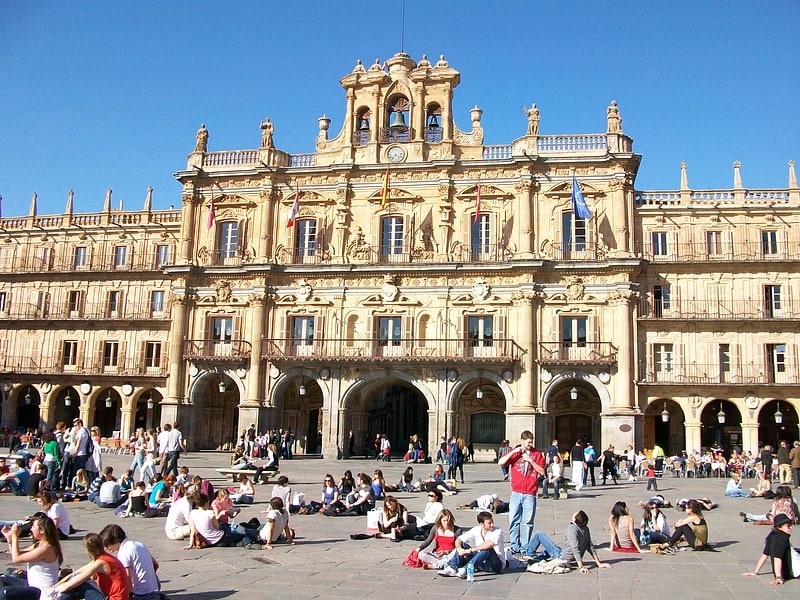
18th-century baroque public square. The Plaza Mayor in Salamanca, Spain is a large plaza located in the center of Salamanca, used as a public square. It was built in the traditional Spanish baroque style and is a popular gathering area. It is lined by restaurants, ice cream parlors, tourist shops, jewelry stores and a pharmacy along its perimeter except in front of the city hall. It is considered the heart of Salamanca and is widely regarded as one of the most beautiful plazas in Spain. It is connected to the shopping area Calle del Toro from the northeast, Calle de Zamora from the north, the restaurants on Calle de Concejo from the northwest, Calle del Prior and the small Calle de la Caja de Ahorros from the west as well as Plaza del Corrillo from the south.[35]
Address: Plaza Major, 37008 Salamanca
Jardín Botánico La Concepción, Málaga
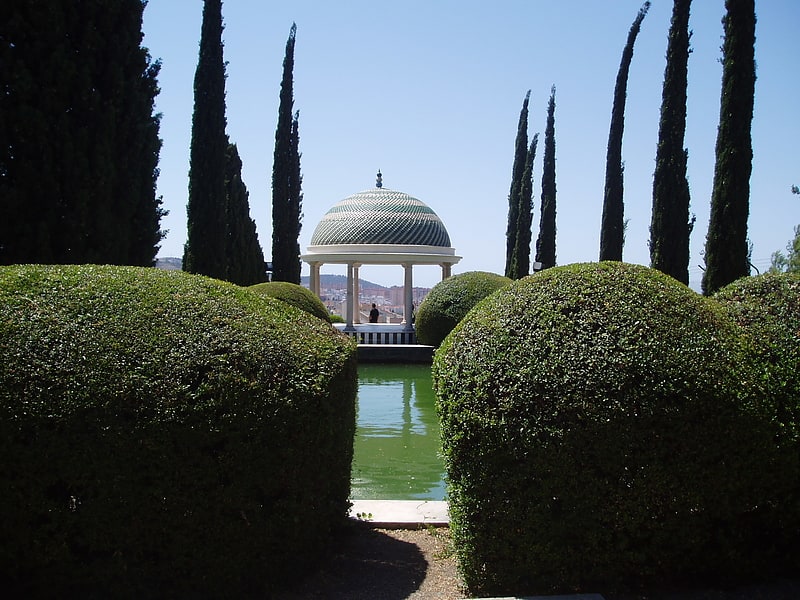
The Jardín Botánico Histórico La Concepción is an English landscape garden with over one hundred and fifty years of history. It is located at the northern entrance of the Spanish city of Málaga. This garden is one of the few gardens with subtropical plants that exist in Europe. It has more than fifty thousand plants, of two thousand species of tropical, subtropical, and autochthonous, highlighting the collection with more than one hundred different species of palms, bamboos, aquatic plants and its historical garden.
It originally was a recreational estate of a family of the upper bourgeoisie of the city from the mid-19th century until 1990 when it became public property. The Málaga City Council founded for its management the Municipal Botanical Board 'Ciudad de Málaga'.[36]
Address: Camino del Jardin Botanico 3, 29014 Malaga (Ciudad Jardín)
Girona Cathedral, Girona
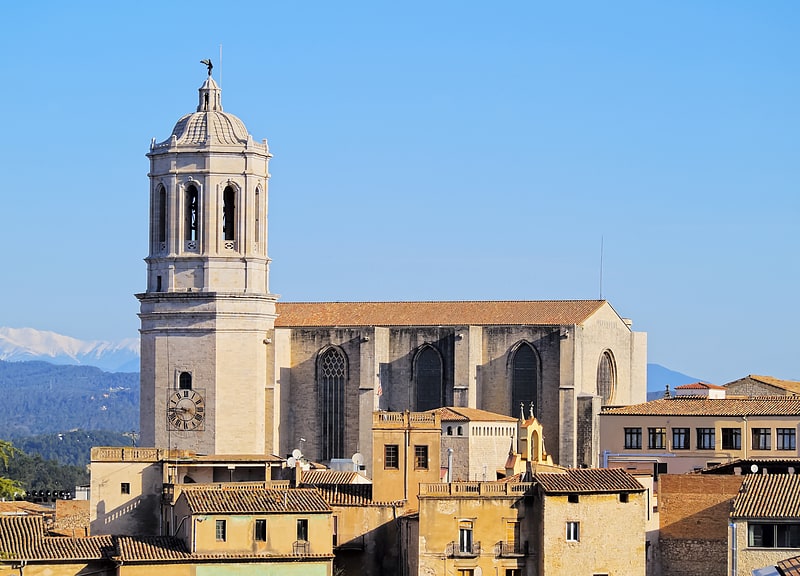
Also known as: Catedral de Santa María de Gerona
Cathedral and world's widest Gothic nave. Girona Cathedral, also known as the Cathedral of Saint Mary of Girona, is a Roman Catholic church located in Girona, Catalonia, Spain. It is the seat of the Roman Catholic Diocese of Girona. The cathedral's interior includes the widest Gothic nave in the world, with a width of 23 metres, and the second-widest of any church after that of St. Peter's Basilica. Its construction was begun in the 11th century in the Romanesque architectural style, and continued in the 13th century in the Gothic style. Of the original Romanesque edifice only the 12th-century cloister and a bell tower remain. The second bell tower was completed in the 18th century.[37]
Address: Plaça de la Catedral, s/n, 17004 Girona
Segovia Cathedral, Segovia

Also known as: Catedral de Segovia
Cathedral in Segovia, Spain. Segovia Cathedral is the Gothic-style Roman Catholic cathedral located in the main square of the city of Segovia, in the community of Castile-Leon, Spain. The church, dedicated to the Virgin Mary, was built in a Gothic style in the mid-16th century.[38]
Address: Calle Marqués del Arco, 1, 40001 Segovia
Museum, Zaragoza
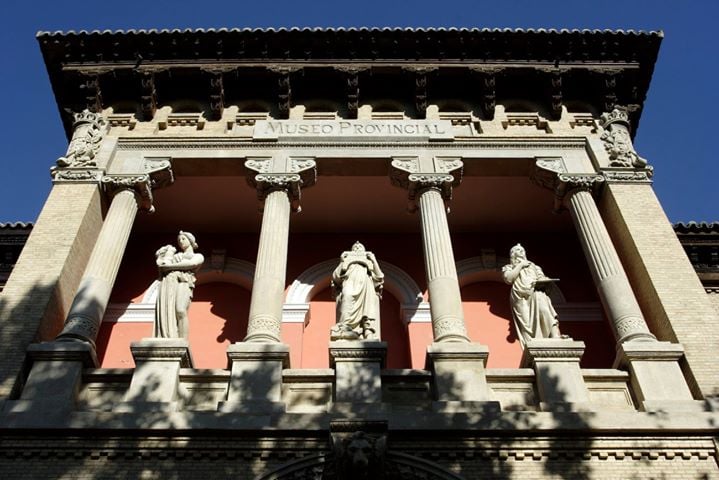
Museum in Zaragoza, Spain. Zaragoza Museum is a national museum in the Plaza de los Sitios in the city of Zaragoza in Spain. Its collections range from the Lower Palaeolithic to the modern era and include archaeology, fine arts, ethnology and Iberian ceramics.
It is the city's oldest museum and its main building - housing the fine arts and archaeology display - is the Neo-Renaissance structure designed for the Spanish-French Exhibition of 1908 by Ricardo Magdalena and Julio Bravo. Its design was inspired by the Patio de la Infanta, home of the Renaissance merchant and patron Gabriel Zaporta. The museum also has an ethnology display at the Casa Pirenaica, a ceramics display at the Casa de Albarracín in the Parque José Antonio Labordeta and the remains of Colonia Celsa in Velilla de Ebro.[39]
Address: Plaza de los Sitios, 6, Zaragoza
National Museum of Science and Technology, A Coruña
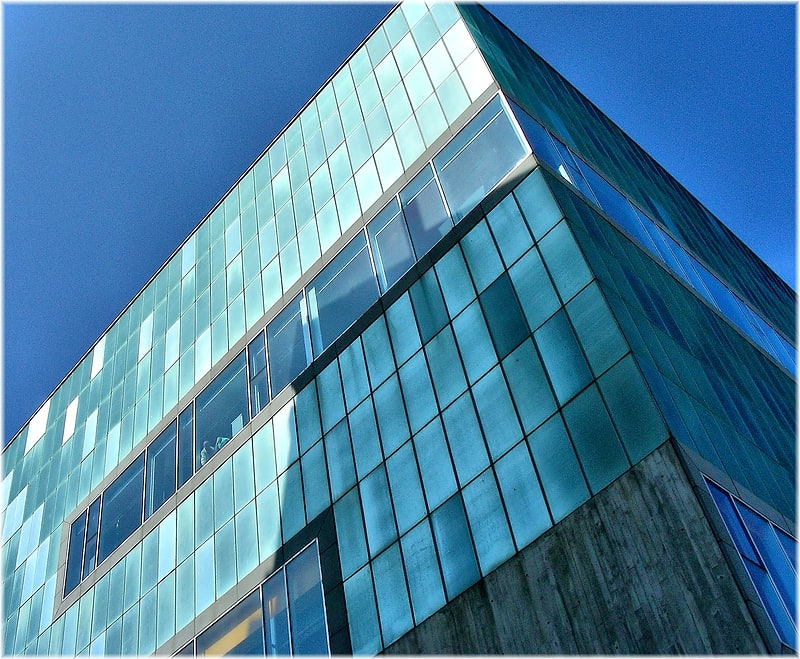
The National Museum of Science and Technology is a Spanish technology museum dedicated to technology promotion and preservation. It owns a collection of more than 17,000 scientific instruments, technological devices, vehicles, machines and industrial tools from the 16th century until nowadays.
The museum was established on June 30, 1980 and its first location was opened on 1997 in the old Delicias railway station building in Madrid sharing premises with the Railway Museum. The museum current main exhibition hall is in La Coruña, opened on May 4, 2012. with a second exhibition hall in Alcobendas (Madrid), opened on December 12, 2014.
Among the pieces in display at La Coruña are the prototype of the "Mechanical Encyclopedia", the 1949 mechanical precursor to the electronic book, by Spanish inventor Ángela Ruiz Robles, the Fresnel lens used between 1857 and 1904 at the Tower of Hercules lighthouse, the first computer arriving in Spain, an IBM 650 computer bought by RENFE in 1959 and the front section of the "Lope de Vega", an Iberia Boeing 747 in service between 1981 and 2003, airplane that brought the Guernica to Spain on September 1981.[40]
Address: Plaza del Museo Nacional, 1, 15011 A Coruña
Pazo de Raxoi, Santiago de Compostela

Also known as: Palacio de Rajoy
18th-century, French neoclassical palace. Pazo de Raxoi is a neoclassical palace in Santiago de Compostela, Galicia, Spain. Completed in 1766, it is located on the Praza do Obradoiro, in front of the cathedral.
It is the seat of the city council and regional government.[41]
Málaga Cathedral, Málaga

Also known as: Catedral de Málaga
Landmark cathedral and a museum. The Cathedral of Málaga is a Roman Catholic church in the city of Málaga in Andalusia in southern Spain. It is in the Renaissance architectural tradition. The cathedral is located within the limits defined by a now missing portion of the medieval Moorish walls, the remains of which surround the nearby Alcazaba and the Castle of Gibralfaro. It was constructed between 1528 and 1782, following the plans drawn by Diego de Siloe; its interior is also in Renaissance style.[42]
Address: Calle Molina Lario, 9, 29015 Málaga (Málaga-Centro)
Museo Nacional de Arte Romano, Mérida
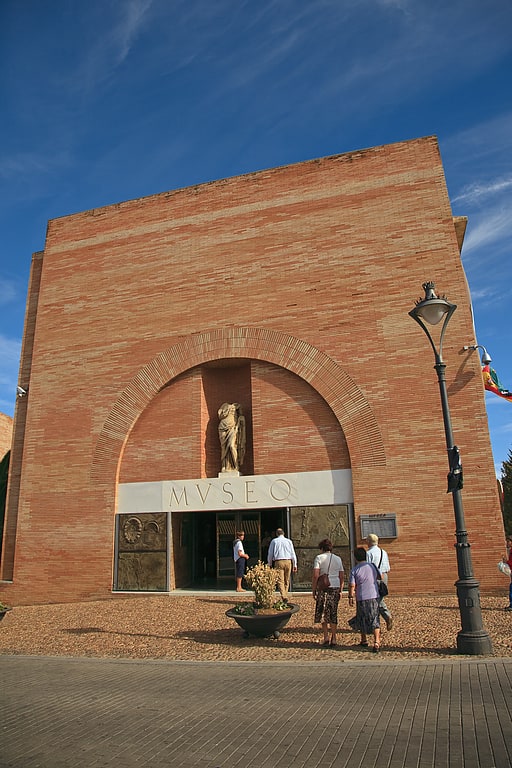
Museum in Mérida, Spain. The National Museum of Roman Art is an archaeology museum located in Mérida, Spain. Devoted to Roman art, it exhibits extensive material from the archaeological ensemble of Mérida, one of the largest and most extensive archaeological sites in Spain, registered as UNESCO World Heritage Site in 1993.[43]
Address: Calle Jose Ramon Melida 2, 06800 Merida
Palacio de la Magdalena, Santander
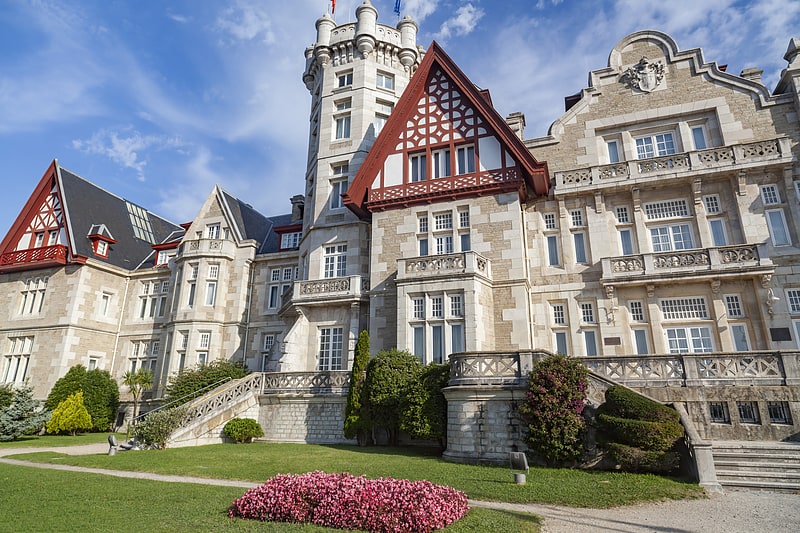
Also known as: Palacio de La Magdalena
Oceanfront palace built in early 1900s. The Palacio de la Magdalena is a palace located on the Magdalena Peninsula of the city of Santander, Cantabria, Spain. It was built between 1909 and 1911, by popular subscription, to house the Spanish Royal Family. Built by the architects Javier González Riancho and Gonzalo Bringas Vega, is located in the place where the old Fort of San Salvador de Hano was, which protected the entrance to the bay.[44]
Address: Península de la Magdalena, 39005 Santander
Aquarium Finisterrae, A Coruña
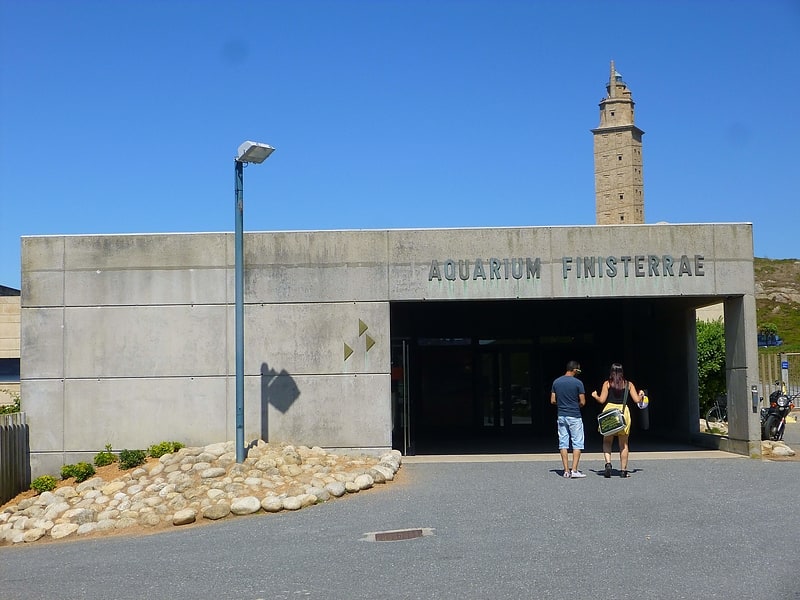
Aquarium in Spain. Aquarium Finisterrae is an aquarium located in A Coruña, Galicia, Spain. It is an interactive centre of the sciences of marine biology, oceanography. It advocates wildlife preservation, particularly the sea ecosystem and sea life.
Founded by the City of A Coruña, it was inaugurated on June 5, 1999. It is directed by Ramón Núñez Centella. Its technical director is Francisco Franco del Amo.
It is located on the coast of A Coruña, in the Maritime Pass, between the Domus (museum) and the Tower of Hercules. Its exterior pools are connected to the Atlantic Ocean.[45]
Address: Paseo Marítimo Alcalde Francisco Vázquez, 34, 15002 A Coruña
Cámara Santa, Oviedo
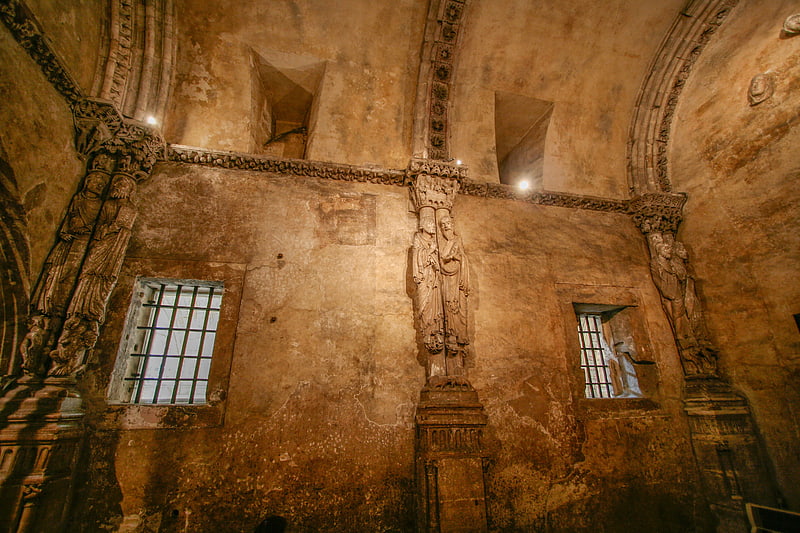
Chapel. The Holy chamber of Oviedo is a Roman Catholic pre-Romanesque church in Oviedo, Spain, built next to pre-romanesque Tower of San Miguel of the city's cathedral. Nowadays, the church occupies the angle between the south arm of the cathedral transept and a side of the cloister.
It was built during the 9th century as a palace chapel for King Alfonso II of Asturias and the church of San Salvador of Oviedo. Apart from acting as royal chapel, the Holy Chamber was built to house the jewels and relics of the cathedral of San Salvador in Oviedo, a function it continues to have 1200 years later. Some of these jewels were donated by the Kings Alfonso II and Alfonso III, and represent extraordinary gold artifacts of Asturian Pre-Romanesque, brought from Toledo after the fall of the Visigothic kingdom.
Consequently, the cathedral of Oviedo was also called Sancta Ovetensis; owing to quantity and quality of relics contained in the Cámara Santa (English: Holy Chamber). The Holy Chamber remains as the only sample of the early medieval complex. It was built as a relics' room to keep the different treasures associated with the Kingdom of Asturias (Cross of the Angels, Victory Cross, Agate box, Arca Santa and Sudarium of Oviedo), brought from Jerusalem to Africa, and after several translations was finally deposited at Oviedo by Alfonso II of Asturias.
It was declared a World Heritage Site by UNESCO in December 1998.[46]
Punta de Teno, Tenerife
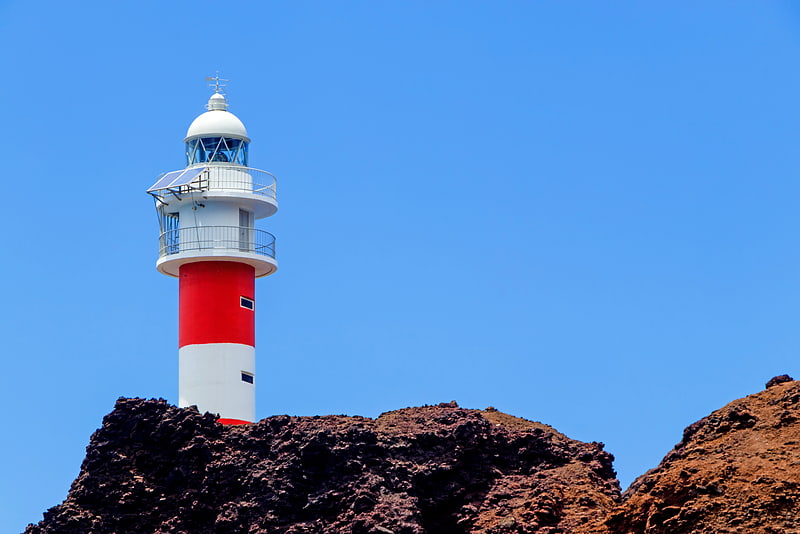
Lighthouse in Spain. The Punta de Teno Lighthouse is an active lighthouse in the municipality of Buenavista del Norte on the Canary Island of Tenerife. The current lighthouse was the second to be constructed on the narrow rocky headland of Punta de Teno, which is the most westerly point on the island. It is one of seven lighthouses which mark the coastline of Tenerife, and lies between the Punta Rasca Lighthouse to the southeast, and the modern lighthouse of Buenavista to the northeast.[47]
Address: Carretera General Punta de Teno, s/n, Tenerife
Royal Palace of La Almudaina, Palma de Mallorca

Also known as: Palacio Real de La Almudaina
Historic palace of the Royal Family. The Royal Palace of La Almudaina is the Alcázar of Palma, the capital city of the Island of Majorca, Spain.[48]
Address: Calle Palau Reial s/n, 07001 Palma de Mallorca (Distrito Centro)
Castillo, Tenerife
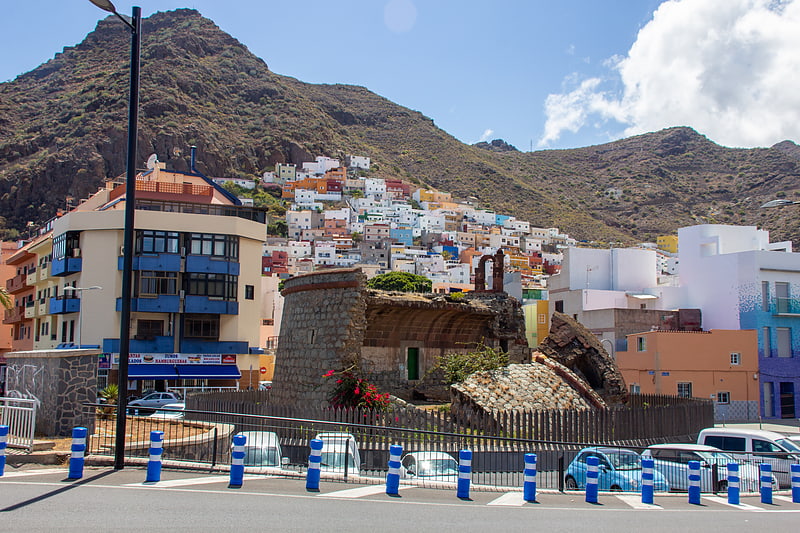
Also known as: Torre de San Andrés
Tourist attraction in San Andrés, Santa Cruz de Tenerife, Spain. The Castle of San Andrés or Tower of San Andrés is located in the village of San Andrés. This castle served to protect the island of Tenerife from pirate attacks.[49]
Cave of Santo Hermano Pedro, Tenerife
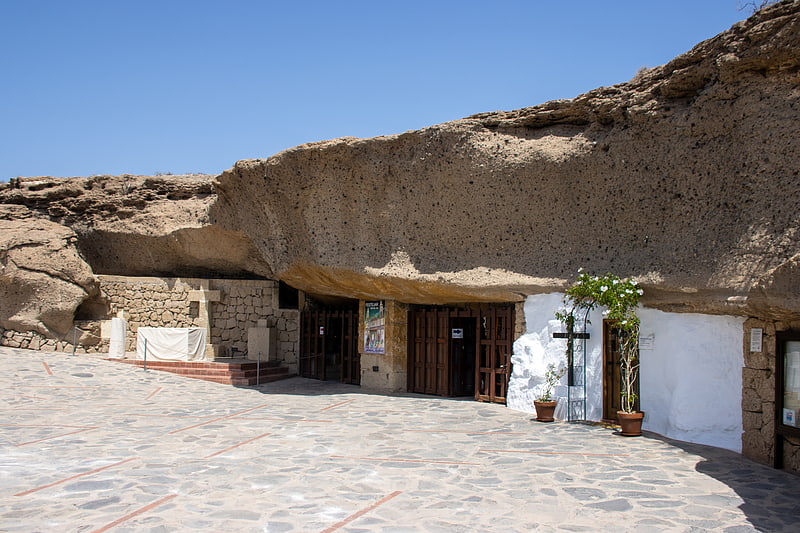
Also known as: Cueva del Santo Hermano Pedro
Shrine in Spain. The Cave-Shrine of Santo Hermano Pedro, is a Roman Catholic cave-shrine dedicated to Saint Peter of Saint Joseph Betancur. It is located in the municipality of Granadilla de Abona, near El Medano on the south of the island of Tenerife, at the end of the Tenerife South Airport runway.[50]